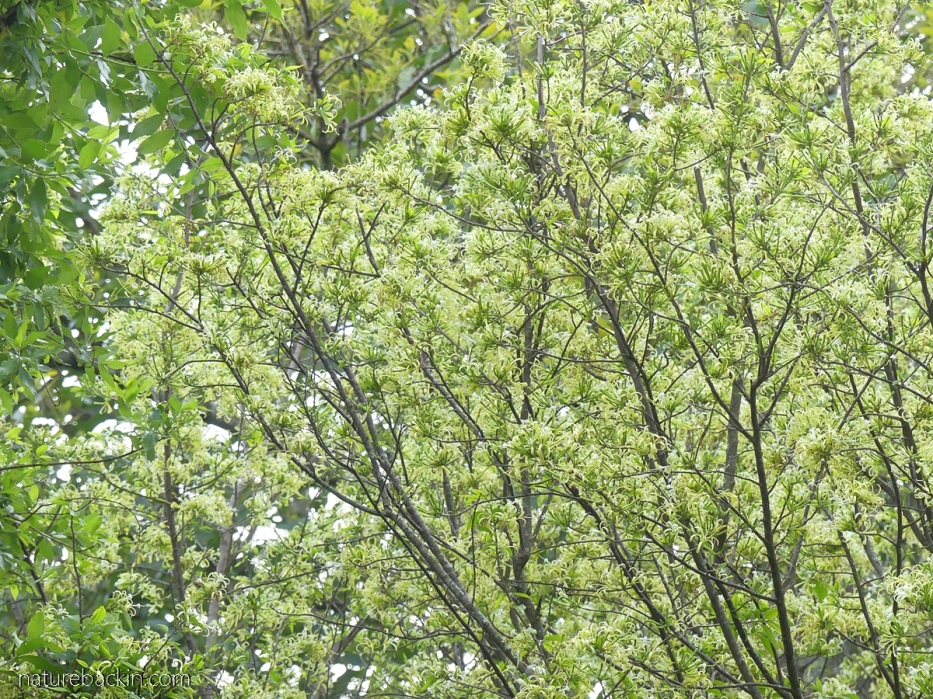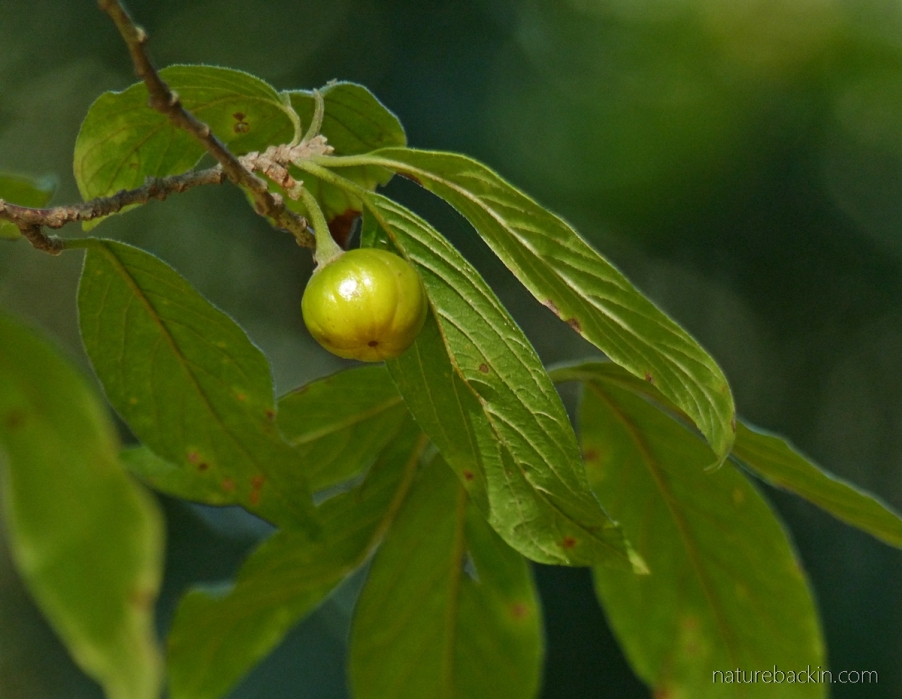The wild honeysuckle tree, also known as the forest honeysuckle tree, is a delightful flowering tree that bears sweetly scented blossoms reminiscent of honeysuckle vines. Though not a true honeysuckle, this South African native puts on a glorious floral display that brightens up woodlands and gardens when in bloom.
Description
The wild honeysuckle tree (Turraea floribunda) is a multi-stemmed tree that can grow up to 10 meters tall It has smooth gray bark and long, elliptical leaves arranged alternately along the branches
The flowers emerge on bare branches before the new leaves sprout. They are creamy-green to pale green in color with a white tubular center containing the stamens. The mildly fragrant flowers grow in clusters of 2-18 blooms.
Flowering occurs in summer and early autumn. The profusion of dainty blossoms on the naked branches is a magical sight. Though the tree produces copious flowers, it bears relatively few fruits. The small, ribbed seed capsules split open when ripe to release orange-colored seeds.
Native Habitat
The wild honeysuckle tree is native to eastern South Africa. Its range extends from the Eastern Cape up into KwaZulu-Natal.
It occurs in the understory layer of coastal, montane, and riverine forests up to elevations of 1000 meters. It thrives in areas with high humidity and rainfall. Outside of forests, it grows along forest margins, woodlands, and ravines.
Cultivation
With its graceful shape and abundant flowers, the wild honeysuckle tree makes a lovely addition to gardens and parks. It can be grown in areas mimicking its native habitat. Partial shade and adequate moisture are key.
-
Soil – Thrives in organic, humus-rich, well-draining soil Dislikes clay
-
Sun – Does best in partial sun to light shade Needs some protection from hot afternoon sun
-
Water – Requires consistent moisture, especially when flowering. Water regularly in dry periods.
-
Hardiness – Tolerates light frost but avoid extreme cold. Best in zones 9-11. Provide shelter if grown outside its hardiness range.
-
Size – Grows to a height of 10 meters but can be maintained smaller. Allow adequate space for its spread.
-
Growth – Moderately fast growing. Prune as needed to shape.
Uses
-
Ornamental – Prized for its floral display and sweet scent. Good for gardens, parks, and patios. Attracts birds, bees, and butterflies.
-
Flowers – Cut sprigs can be used in floral arrangements.
-
Fragrance – The flowers release their honeysuckle-like aroma most strongly at night. Plant near patios and doors to enjoy.
-
Honey – The nectar-rich blossoms produce good quality honey. A favorite of beekeepers where it occurs.
-
Medicine – Traditional uses of the bark and roots include treating rheumatism, heart conditions, inducing trance states.
-
Wood – The wood is hard and durable but not commercially important due to the tree’s small size. Used locally for tools, spoons, knobkerries.
Problems
-
Overwatering – Sensitive to overwatering. Ensure soil drains well.
-
Frost – Needs shelter from hard freezes. Cover or bring indoors if grown outside its range.
-
Sunburn – Susceptible to leaf scorch if exposed to too much hot afternoon sun.
-
Porcupines – Can damage bark and kill trees. Monitor for porcupine damage and wrap trunks if needed.
The Takeaway
The wild honeysuckle tree may not be a true honeysuckle but it is just as captivating. When blanketed in sweetly scented blooms, it’s easy to see why it’s so beloved. For gardens seeking floral enchantment, this flowering beauty always delivers. Give it a try and let it charm you too!
at home and further afield

The flower-filled wild honeysuckle tree has lost its leaves very early in the spring and is now in full flower. Flowering on bare stems with the new leaves just starting to sprout it puts on a lovely show.

The flowers of the Wild Honeysuckle-tree (Turraea floribunda) are sweetly fragrant. The petals are a soft shade of green, and they surround a long, white tube in the middle that is made when the stamens join together. At the end of the stamen tube a frill carries the pollen-bearing anthers. The style sticks out past the end of the stamen tube and ends in a small head that looks like a knob. This is where pollinators, like birds and insects, spread pollen. According to Boon, the flowers are pollinated by visiting hawk moths and sunbirds.

The two sources I looked at both say that the petals are a “creamy-green” color, while Manning says they are a “delicate pistachio-green.” The flowers are borne in groups of two to eighteen. At first, the groups only have the long, thin buds, but later they have both buds and fully opened flowers.

The flowers are coming out on the stems that are still bare because the new leaves are just starting to grow. The clusters of buds and flowers look especially beautiful against a blue sky.


But equally the flowers are lovely against the green foliage of the surrounding trees. This tree grows in forests and can be found in the eastern parts of South Africa’s Eastern Cape and KwaZulu-Natal. Its broader range extends as far north as Sudan.

Part of the honeysuckle tree’s scientific name that means “prolifically flowering” is “floribunda.” In early summer, it really does live up to its name.



It’s strange that I haven’t seen many fruits on the tree since it has so many flowers. In fact Manning comments that remarkably few fruits are produced for so many flowers. On our tree I have only noticed one or two of the small fruit capsules per season.

As the fruit gets riper, it splits along its ribs into star-shaped pieces with orange seeds on each one. However, I only have a photograph of the split woody capsule after the seeds have dropped.

A couple of weeks ago I found a dry capsule on the ground beneath the tree. I collected it and snapped a photo of it with my phone this evening.

In an earlier post about porcupines, we talked about our honeysuckle tree. The trunk had been chewed on by a visiting porcupine (or porcupines), and some of the bark had been chewed off the base of the trunk. The porcupines don’t seem to be interested in the tree anymore, which is good, because it hasn’t done any damage since then.
The tree is multi-stemmed and its greyish bark is decorated with lichen. I took the photo below in the early dusk this evening using my cell phone.

I wish I could convey to you the sweet scent of the flowers. It is easy to imagine them attracting night flying insects, such as hawk moths.
Boon says that the roots and bark are used to treat rheumatism and heart problems, and that they are also used in magic to put people into a trance. From my perspective it certainly is an entrancing tree.


Sources:
Boon, Richard. 2010 (2nd ed.). Pooley’s Trees of Eastern South Africa. Durban: Flora & Fauna; Manning, John. 2015. Turraea floribunda. PlantZAfrica. South African National Biodiversity Institute (SANBI). http://pza.sanbi.org/turraea-floribunda

Posted by Carol

Sharing ideas and honoring the animals and plants that make suburban areas better, with pictures from my old garden in KZN and my new garden in the Western Cape in South Africa, as well as pictures from wild places further away

Turning A Shrub Into A Standard Tree || It’s Just So Easy!
- The Ultimate Guide to Growing Strawberries in Raised Beds - August 8, 2025
- No-Dig Garden Beds: The Easiest Way to Grow a Beautiful Garden - August 6, 2025
- How to Protect and Preserve Wood for Raised Garden Beds - August 6, 2025

